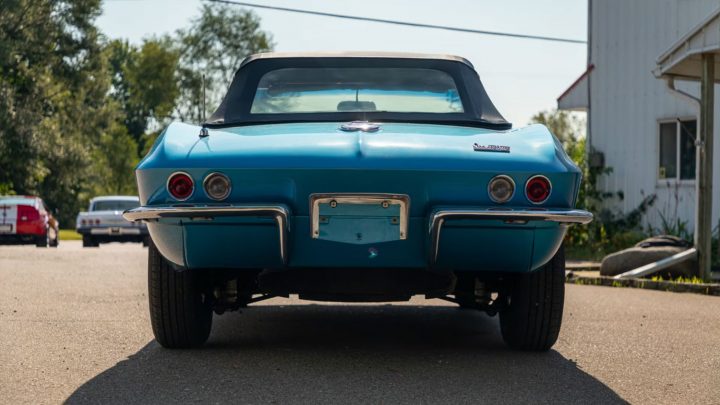The Chevy Corvette received a full redesign for the 1963 model year. The all new ‘Vette, aka the Sting Ray, was one of Bill Mitchell’s first projects after replacing Harley J. Earl as GM Styling Section Vice President. The Sting Ray was based on the 1959 Sting Ray racer, with a center spine (on the coupe) that bisected the rear window, running to the rear of the car, giving it the look of a stingray’s backbone.
The new Chevy Corvette had a number of “firsts.” For the first time, there was a coupe variant to go with the convertible. The previous generation’s Safety Girder X-Frame was abandoned in favor of a perimeter-type frame. An independent rear suspension replaced the previous solid axle, greatly improving ride and handling. Headlights were a flip-up design, hidden when not in use. The fenders were widened and arched, giving the car a pinched or “Coke bottle” shape. The rear end had a strong resemblance to that of the 1961 and 1962 Corvettes, with two taillights per side. Production totaled 21,513 units, 10,594 coupes and 10,919 convertibles.
The Chevy Corvette also received a completely redesigned interior, with dual dash binnacles, large speedometer and tachometer, and smaller gas, battery, temp, and oil gauges. Radios were oriented vertically rather than horizontally. There was a lockable glovebox on the passenger side that replaced the storage compartment previously located between the seats. Above the glovebox was a passenger grab handle.
Engine and transmission choices were mostly carried over from the 1962 Chevy Corvette, save for larger intake plenums on the fuel-injected engines. During the 1963 production year, the manual transmission supplier was changed from BorgWarner to Muncie.
By 1966, the Chevy Corvette had received a number of appearance and drivetrain changes. The faux vents and depressions in the hood were gone, the vents on the front fenders had morphed into three functional vertical slots, the Corvette script on the outside of the car and on the glovebox door had become more vertical in appearance, and the B-pillar vents on coupes had been eliminated. Disc brakes became standard equipment in 1965. 1965 was the final year for mechanical fuel injection, and all engines came with standard Holley carbs. The 396 Mark IV Big Block, rated at 425 horsepower, debuted for 1965. For 1966, the Mark IV grew to 427 cubic inches in displacement. Two different versions were available, one rated at 450 horsepower and one at 400. Early in the production year, the 450 rating was reduced to 425 horsepower, and the 400 was reduced to 390. This was purely an administrative change, as nothing mechanically was modified on the engines. Small Block engines could be had in 300- and 350-horsepower ratings.
Our feature 1966 Chevy Corvette convertible has been owned by the Ray Oliver Collection for the last 25 years. Finished in shiny Nassau Blue with black convertible top over a black vinyl interior, the Sting Ray is powered by the 425-horsepower 427 Big Block fed by a Holley carb atop a Winters aluminum intake, and backed by a four-speed manual transmission. The Big Block exhales spent gasses through factory side-mount exhaust. The Corvette is equipped with four-wheel disc brakes, a Delco AM-FM radio, and heater/defroster. Painted steel wheels wear spinner hubcaps, and are wrapped in radial rubber. Included in the sale is the owner’s manual and Protect-O-Plate.
This 1966 Chevy Corvette Big Block convertible will cross the Mecum Auctions block at their Indy Fall Special taking place October 3rd through the 5th.




































Comments
Wanna even trade for my 2021 C8 Stingray convertible???
Sweet machine!
All carbs were NOT Holly. The ’65 with 327 small block had carter WCFB for 250 HP version and Carter AFB for 300 HP version. The 300hp also needed bigger intake manifold, bigger valves, and bigger exhaust manifold and pipes.
There wasn’t a 250hp engine option in 1966; base motors were 300hp. All 1966 Corvettes were equipped with Holley carbs per Michael Antonick’s Corvette Black Book.